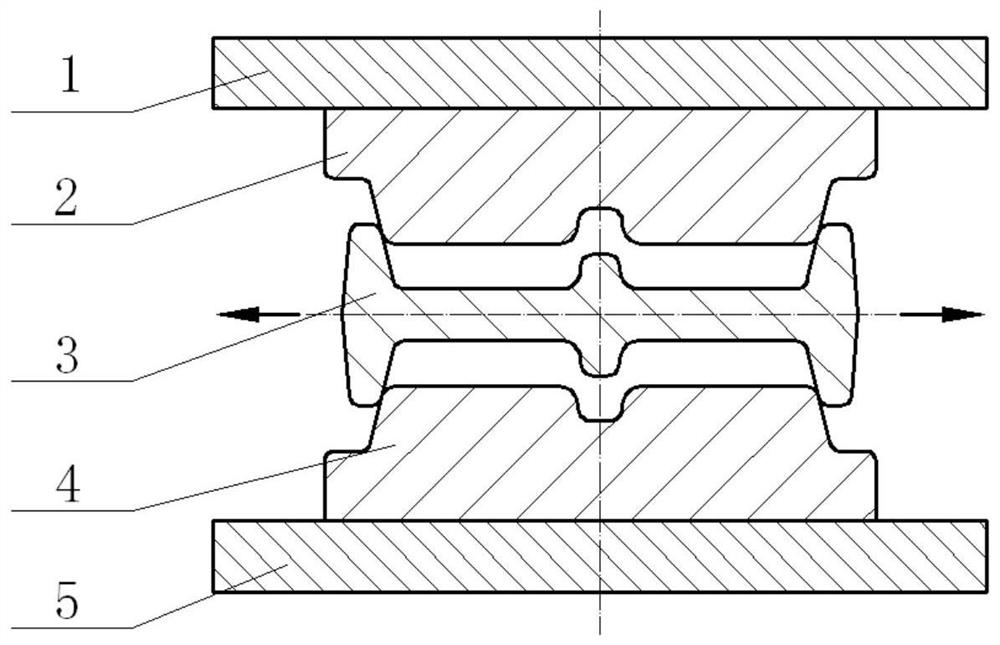A Method for Reducing Quenching Residual Stress of High Strength Aluminum Alloy Large Frame Die Forgings
A residual stress and aluminum alloy technology, applied in forming tools, metal processing equipment, manufacturing tools, etc., can solve the problems of inability to aging treatment, heavy weight, and pollution
- Summary
- Abstract
- Description
- Claims
- Application Information
AI Technical Summary
Problems solved by technology
Method used
Image
Examples
Embodiment 1
[0018] The 7050 high-strength aluminum alloy large-scale frame die forgings prepared by the same forging process were subjected to solution treatment, and the draft angle of the ribs was 3° and the height was 50mm. The cavity size of the cold drawing die is 1.015 to 1.025 times that of the high-strength aluminum alloy large frame die forging, and the side wall slope is 4°. The solid solution temperature is 475°C±5°C, enter the water vertically, and the end with the larger length enters the water first, the quenching water temperature is 60°C±5°C, and the quenching transfer time is less than 15s. The quenching is completed after the forging is kept in water for 20mins. After quenching, place the forging in the lower die for cold drawing, and adjust the position of the forging so that the burr at each position of the forging is consistent with the gap between the lower die. Start cold stretching, the initial speed of the upper die is 0.5mm / s, and the speed is 0.15mm / s after the...
Embodiment 2
[0022] The 7085 high-strength aluminum alloy large-scale frame die forging prepared by the same forging process was subjected to solution treatment, and the rib draft angle was 5° and the height was 80mm. The cavity size of the cold drawing die is 1.015 to 1.025 times that of the high-strength aluminum alloy large frame die forging, and the side wall slope is 6°. The solid solution temperature is 475°C±5°C, enter the water vertically, and the end with the larger length enters the water first, the quenching water temperature is 60°C±5°C, and the quenching transfer time is less than 15s. The quenching is completed after the forging is kept in water for 20mins. After quenching, place the forging in the lower die for cold drawing, and adjust the position of the forging so that the burr at each position of the forging is consistent with the gap between the lower die. Start cold stretching, the initial speed of the upper die is 0.5mm / s, and the speed is 0.20mm / s after the stroke ex...
Embodiment 3
[0026] The 7150 high-strength aluminum alloy large-scale frame die forging prepared by the same forging process was subjected to solution treatment, and the rib draft angle was 7° and the height was 120mm. The cavity size of the cold drawing die is 1.025 to 1.035 times that of the high-strength aluminum alloy large frame die forging, and the side wall slope is 11°. The solid solution temperature is 475°C±5°C, enter the water vertically, and the end with the larger length enters the water first, the quenching water temperature is 60°C±5°C, and the quenching transfer time is less than 15s. The quenching is completed after the forging is kept in water for 20mins. After quenching, place the forging in the lower die for cold drawing, and adjust the position of the forging so that the burr at each position of the forging is consistent with the gap between the lower die. Start cold stretching, the initial speed of the upper die is 0.4mm / s, and the speed is 0.25mm / s after the stroke ...
PUM
| Property | Measurement | Unit |
|---|---|---|
| residual stress | aaaaa | aaaaa |
| tensile strength | aaaaa | aaaaa |
| yield strength | aaaaa | aaaaa |
Abstract
Description
Claims
Application Information
 Login to View More
Login to View More - R&D Engineer
- R&D Manager
- IP Professional
- Industry Leading Data Capabilities
- Powerful AI technology
- Patent DNA Extraction
Browse by: Latest US Patents, China's latest patents, Technical Efficacy Thesaurus, Application Domain, Technology Topic, Popular Technical Reports.
© 2024 PatSnap. All rights reserved.Legal|Privacy policy|Modern Slavery Act Transparency Statement|Sitemap|About US| Contact US: help@patsnap.com








